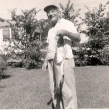Early April 1970 offered some beautiful Gulf coast weather. Light winds and warm days had raised the water temperature to over seventy degrees, the speckled trout, or specs, had spawned and now had moved onto the sand/shell flats prowling for food and it was mine and Jim Buck, my Brother-In-Law’s, plan to intercept some of these monsters.
Our ambush point was the sand flats, on the south side of the spoil banks of the Intercoastal Waterway, just west of Greens Cut, but not as far as Karankawa Reef where the sand flats turned into mud/shell. Two months earlier, on a warm February afternoon, the mud had offered us some good fishing, but now the specs had changed to their spring and early summer pattern.
Jim and I were using live shrimp under a popping cork, but weren’t blind casting and drifting. Our targets were the slicks made by the specs gorging and regurgitating bits of their prey. The oil released will pop to the surface as a pail or washtub size, shiny, oily slick and the trout will be under the slicks. A telltale sign produced by the slicks is a distinctive water melon, smell and many times we’d pick up the odor before we found the slick.
We were idling along in my new seventeen foot, deep vee, cross wind to a light southeast breeze, and sure enough, Jim said, “I smell ‘em” as I also picked up the unmistakable scent of watermelon. Scanning the immediate area, we both saw slicks popping to the surface less than a hundred feet to our left and cutting the outboard, we looped short casts between two of them and were both rewarded with solid strikes. After a few short runs, a boat circling battle ensued and we let the specs tire before slipping nets under them and claiming a brace of fine three pound, trout!
 Pictured is my new, 17′, deep vee. It was so new I hadn’t even applied the state required registration decals.
Pictured is my new, 17′, deep vee. It was so new I hadn’t even applied the state required registration decals.
Restarting the motor, we continued looking and sniffing and came upon a tub size slick to our front. Jim shot a cast toward it, popped his cork once, a spec smashed the shrimp and headed off across the bay. Rod tip held high, Jim’s fish began the first of three circles of the boat, each being closer, until laying on its side, I easily slipped the net under it and hefted a nice five pounder aboard. Jim had been fishing for specs for the past four years and this was his best one to date. He was happy and, smiling, told me, “I’ll drive the boat and you catch the next one!”
Within fifteen minutes we both caught the scent and as I cast toward the emerging slick, I remarked to Jim, “I’ll bet this’l be a nice one.” No sooner as the shrimp hit the water, there was a smashing strike! The fish headed “south” and all I could do was hold on. Finally, stopping the run, I was surprised when the fish headed back towards the boat. Most times a good spec will begin circling, conserving its energy, then really put up a scrap beside the boat, but not this one.
Reeling madly and barely keeping pressure on the fish, it rolled a short distance from the boat, revealing a flash of silver and we both remarked, “That’s some spec!” It made several short runs and stirred the water to “a froth” around the boat, but finally tired as Jim netted it and held it up for both of us to admire. We guessed that it weighed over six pounds.
 We had already filleted the other three fish and belatedly decided to, at least, take a picture of the big ‘un!
We had already filleted the other three fish and belatedly decided to, at least, take a picture of the big ‘un!
We had four very nice specs in the cooler and called it a day. We loaded the boat and drove to Red’s, 7 Seas Grocery, to weigh my big fish. Red, the owner, was holding court with several of his friends, and even though it was before lunch, he and his pals were well into the sauce. Declining his offer to join into the festivities, I asked if we could weigh a big trout that I had just caught? “By all means,” he replied.
Showing off the big fish, it brought “ooohs and ahs” from the group and placing it onto his meat scales, the meter stopped at seven pounds and two ounces. This was a “best” for me for the next twenty-one years!








